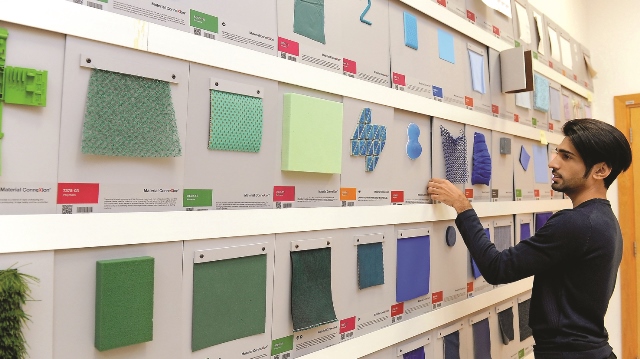
Materials Library at VCUQatar is poised to become a regional research destination for artists and designers. Pic: Salim Matramkot / The Peninsula
There are not many ‘materials libraries’ in the world, and Qatar has the only one in the region with a collection of more than 10,000 items procured from around the world.
A ‘materials library’ is a critical resource found in only the best art and design schools. And the one at the Virginia Commonwealth University Qatar (VCUQatar) in Education City, fully supports all creative endeavours and industries, unlike some materials libraries that are dedicated exclusively to architecture and architectural engineering. Its collections support projects in interior architecture, fashion, graphic design, printmaking, as well as interdisciplinary design.
The library collection includes physical materials, samples and books relating to a range of different disciplines, and it is aimed to become a regional research destination for artists and designers.

The Peninsula spoke with Amy Andres, Director of Libraries at VCUQatar as well as to Abdul Rahman, Materials Library Curator about the uniqueness of the region’s only ‘Materials Library’.
“The VCUQatar Materials Library is an interactive resource, a studio, and laboratory for the curious mind where materials can be explored by conducting hand-on research through testing and experimentation,” says Amy.
The Materials Library at VCUQatar was started in 2010 through the dedication and expertise of its first curator, Richard Lombard.
Initially, the collection was focused on interior design in order to support the department’s accreditation process.

Over the years materials were added to support all of VCUQatar’s academic departments. Seven years later, the library continued realising the vision of Qatar Foundation by inspiring innovation in design creativity through the exploration and use of physical materials.
The library collection holds up to 10,000 items procured from around the world, including physical materials samples and books relating to a range of different disciplines.
“The large collection of the materials library has been carefully cultivated and handpicked piece-by-piece, based on the university’s curricula. Moreover, the library collection houses a physical searchable database from Material ConneXion, a New York-based materials firm that provides us with hundreds of new and innovative material samples on annual basis. Each year the library collection continue to evolve and grow in terms of its size, usage and impact on the community and by keeping its collection up to date with new trends, and technologies,” says Abdul Rahman.
The library collection includes materials as 3ajeeb as meat glue, unusual materials such as rheoscopic fluid to visualise water flow, to strange materials such as ferrofluid, complex materials as high-density foam for the CNC milling machine, fundamental materials for sculpting, and to precious materials, such as hand-stitched Japanese shibori samples.
“The library serves as a contemporary Cabinet of Curiosities that invites imaginative inquiry. Artists and designers have referred to the Materials Library as ‘Disneyland,’ a ‘WonderLand,’ and ‘Heaven on earth.’ These descriptions reflect the impression after a visit to the library, where one can explore the physical, visual, and tactile world of materials,” says Abdul Rahman.
Further, the Materials Library at VCUQatar, along with the main art and design library, is poised to become a regional research destination for artists and designers.
“Looking forward, the library will continue to develop its collections so they offer VCUQatar students and faculty, as well as the designers of the community, a current and constant stream of possibilities that will inspire and contribute toward their artistic and creative productivity. We are also building a geo-database of local and regional vendors so we can help artists and designers source materials and products. There is a wealth of incredible materials available in Doha and it is important for us to serve as leader in building a local materials network,” says Amy.
“We would also like to expand our materials testing capabilities. We have in-house expertise we can draw upon but we hope to acquire cutting edge technologies that will push the creative abilities of our students and faculty as far as they can go, while providing additional methods for them to understand the physical and tactile characteristics of the various materials,” she added.

It is also a core part of Materials Library at VCUQatar’s mission to use its collections and expertise to contribute to the creative output of Qatari designers.
“In the next year or so, we would like to identify a Qatari designer who can make use of our collections in order to take their work to the next level. We anticipate exciting outcomes for those designers who are exposed to all we have to offer through our collections,” says Amy.
Materials Library at VCUQatar is open to the public, and its materials curator will assist local artists and designers in identifying materials and by explaining their core attributes -- for example, the material’s production method or how it can be manipulated or fabricated.
The library has successfully collaborated with other Education City institutions including Georgetown, Texas A&M, Carnegie Mellon, as well as with individuals and organisations, for example, Stars of Science.




